Core i7-4960X Extreme Edition, Core i7-4930K and Core i7-4820K Review: The LGA 2011 Refresh

Intel had refreshed their long-life LGA 2011 platform and had released new 22-nm Ivy Bridge-E processors instead of old Sandy Bridge-E. But we have doubt about the new CPUs can breathe new life into old high-priced enthusiast platform. Read our review!
It is Intel’s new CPUs with Haswell microarchitecture that interest users the most. Their benefits, though not numerous, are indisputable. They offer increased performance, a much faster integrated graphics core, and better energy efficiency. However, Haswell-based CPUs are not so good for a desktop PC enthusiast. The problem is that Intel’s desktop CPUs are actually made of mobile CPUs with certain adaptations, so they have rather low frequency potential and high operating temperatures on desktop PCs.
We shouldn’t forget that the Haswell is not the top-end desktop offer from Intel, though. Especially for enthusiasts Intel supports the LGA2011 platform which traces its origin back to server rather than mobile solutions. And it is a platform with most enticing specs. LGA2011 CPUs have a lot of execution cores and an increased number of PCIe lanes, which is advantageous for multi-GPU configurations. The memory subsystem bandwidth is fantastically high. The only problem is that LGA2011 CPUs get updated at a much slower rate than Intel’s microarchitectures.
Until recently, the LGA2011 CPU series included only models with Sandy Bridge-E microarchitecture which was announced about 2 years ago. Fortunately, Intel has plans to develop this platform further as is indicated by the recent large-scale update. The LGA2011 platform itself remains unchanged, which is good news for users who prefer to upgrade their components one by one, but there are new LGA2011 CPUs available now. Manufactured on 22nm tech process with 3D transistors, they represent the more advanced Ivy Bridge-E microarchitecture.
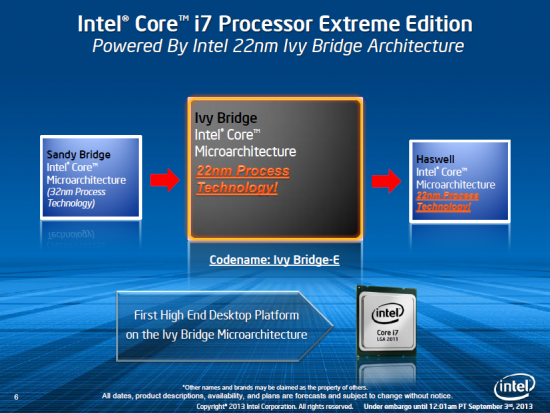
Of course, enthusiasts would prefer the new CPUs to be based on the Haswell-E design because the Ivy Bridge microarchitecture was introduced about a year ago. It so happens that the LGA1150 platform, being a lower-class solution, features more advanced CPUs now. However, there is an easy explanation why we have Ivy Bridge-E based LGA2011 CPUs. Intel’s flagship desktop platform is directly related to the Xeon series and the server ecosystem doesn’t have to evolve as quickly as mobile solutions. On the contrary, changing CPU generations too often and losing backward compatibility in the process is not desirable for buyers of expensive servers who want long-time support for their investment.
That’s why Intel just couldn’t release Haswell-E CPUs that would have required an overhaul of the entire infrastructure and called for a new CPU socket. The Haswell-E will only come out in the second half of the next year when the LGA2011 platform will be nearing the end of its 3-year lifecycle. The growing gap between the server and desktop CPU designs hardly matters for server users because for them the number of CPU cores is more important than their microarchitecture.
So, today, you can upgrade to the Ivy Bridge-E and enjoy a large number of CPUs cores, PCI Express lanes and memory channels, but you won’t get Intel’s most up-to-date CPU microarchitecture available. The question arises whether the revised LGA2011 platform can compete with the new LGA1150. To answer it, we are going to benchmark the full series of LGA2011 desktop CPUs of the model year 2013 in comparison with top-end models featuring newer CPU designs.
Ivy Bridge-E and LGA2011 in Detail
To emphasize the premium status of the desktop LGA2011 platform, Intel offers a limited CPU model range for it. The Ivy Bridge-E series announced some time ago only includes three models:
These processors replace the earlier Sandy Bridge-E products and come at the same prices. The Core i7-4960X Extreme Edition becomes the flagship model instead of the Core i7-3970X. The Core i7-4930K replaces the midrange Core i7-3930K. As for the Core i7-4820K, this quad-core CPU is somewhat more expensive than its predecessor Core i7-3820 because it’s got the letter K in its name. In other words, the junior model now features an unlocked frequency multiplier, just like its senior cousins. It is still about $15 or $20 cheaper than the Core i7-4770K, the top-of-the-line Haswell-based LGA1150 model, which is reasonable considering the older microarchitecture employed in the Core i7-4820K.
The transition of the LGA2011 CPUs to the Ivy Bridge-E design has had but a little effect on their specs (see the table above). The number of execution cores, Hyper-Threading support and L3 cache amount are the same as with their predecessors. As for the clock rates, the Ivy Bridge-E CPUs have got 100 to 200 MHz faster. However, the Turbo frequency is limited to 4.0 GHz for the Core i7-4960X, exactly as for the Core i7-3970X. Now Intel has two desktop CPUs capable of working at 4 GHz whereas the Haswell-based series is limited to 3.9 GHz in Turbo mode.
Considering the overall similarity between the Sandy Bridge-E and Ivy Bridge-E designs, it is remarkable that the new CPUs have a special 6-core semiconductor die. The previous generation was based on the 8-core die of server CPUs with two cores disabled but now the die only contains six physical computing cores. As a result, the Ivy Bridge-E has a considerably smaller die than the Sandy Bridge-E: 257 vs. 435 sq. mm. Of course, the 22nm technology contributes to the miniaturization as well, but the total number of transistors has also been reduced, from 2.27 to 1.86 billion.
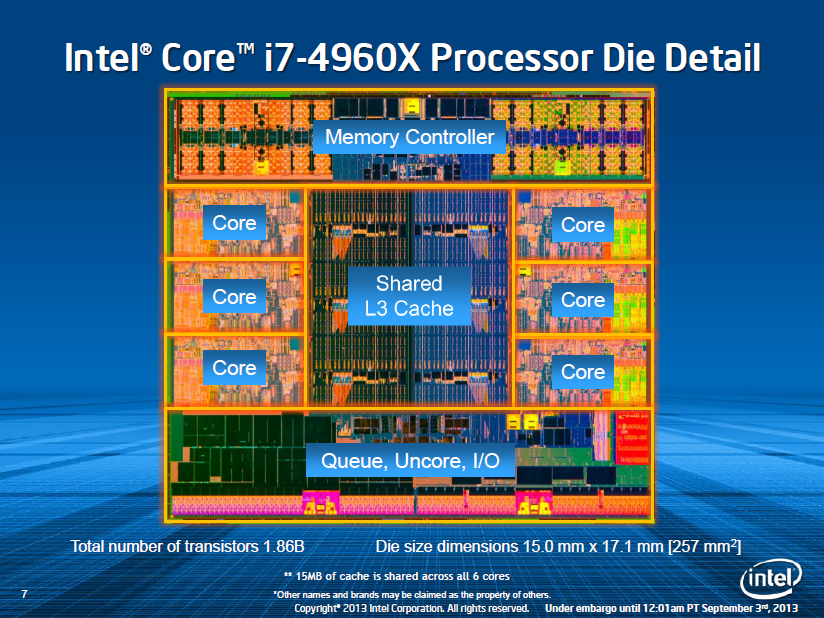
The removal of the two unneeded cores from the die might have been accompanied with an increase in the cache memory amount, yet the L3 cache is still only 15 megabytes in the senior CPU model. The midrange and the quad-core junior models have 12 and 10 megabytes of L3 cache, respectively. The only memory-related innovation concerns the top frequency supported officially. The Ivy Bridge-E is declared to be compatible with DDR3-1866 (with one module per channel) although such CPUs can work with faster memory modules in practice.
The TDP of the senior Ivy Bridge-E has been reduced. The Core i7-3970X used to have a TDP of 150 watts whereas the Ivy Bridge-E series have a TDP of 130 watts.
The fact that the new LGA2011 CPUs are fully compatible with the old platform, announced two years ago, is both good and bad. It is good to have an opportunity to easily upgrade your old computer with a new CPU. But it is bad that the only LGA2011-compatible chipset, Intel X79, is rather outdated already.
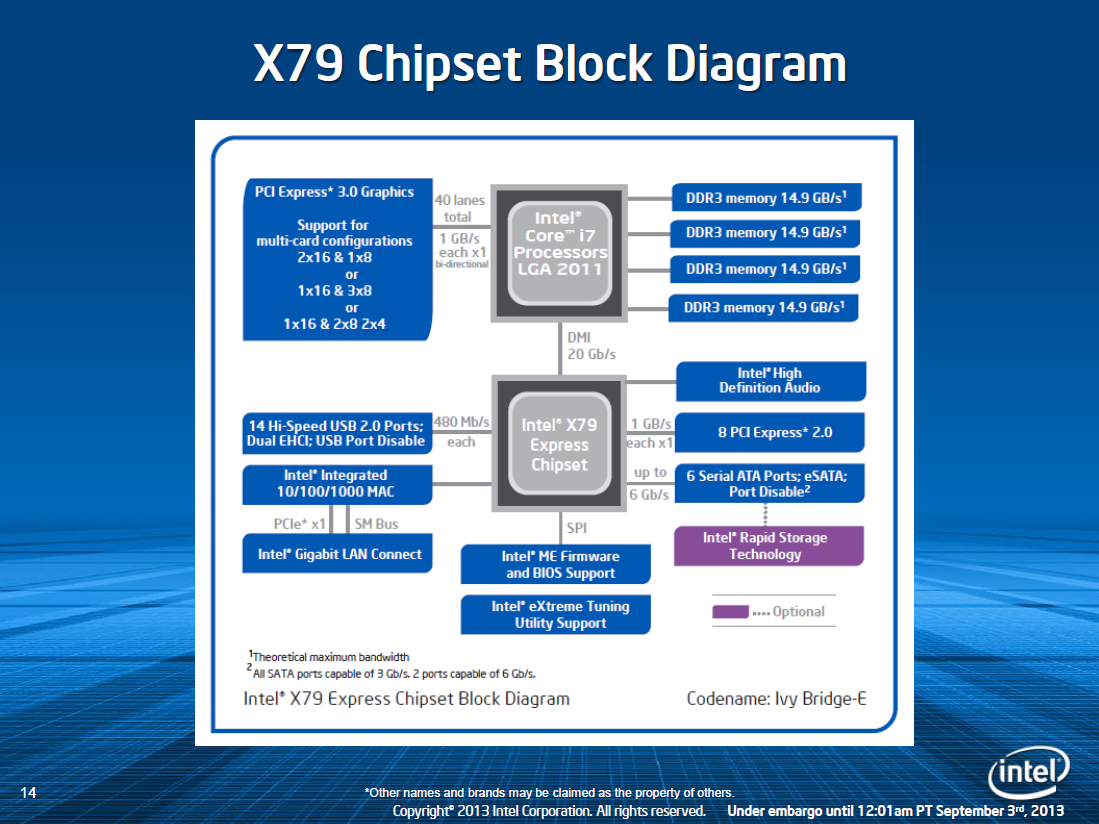
The chipset doesn’t support USB 3.0 and has only two SATA 6 Gbit/s ports. It means that mainboard makers have to add third-party controllers to implement these interfaces, which has negative consequences in terms of price and compatibility. The X79 leaves no alternatives, though.
And still, the opportunity to install a completely new CPU onto a 2-year-old mainboard seems to be most attractive to us. The LGA2011 platform suggests this upgrade scenario as old LGA2011 mainboards become fully compatible with the Ivy Bridge-E CPUs after a simple BIOS update with only one and very odd exception – Intel’s own mainboards. Intel has been shutting down its mainboard business and doesn’t plan to release new firmware for its LGA2011 products. So, unfortunately, owners of such rather good mainboards as Intel DX79SI, DX79SR and DX79TO are left without support for the new CPUs.
The long lifecycle of the LGA2011 platform is not its only advantage. Besides offering more computing cores than top-end LGA1150 CPUs, the Ivy Bridge-E processors provide more PCIe lanes and feature a unique quad-channel memory controller.
As opposed to LGA1155 and LGA1150 CPUs that offer 16 PCIe lanes for the graphics subsystem, LGA2011 CPUs offer 40. This is true for both S
andy Bridge-E and Ivy Bridge-E generations, but the newer models support PCI Express 3.0. The latter standard was implemented in the Sandy Bridge-E but lacked official validation, so Nvidia’s GeForce cards worked in PCIe 2.0 mode by default and the user had to do some manual setting-up to make them work in PCIe 3.0 mode. There should be no such problems with the new LGA2011 CPUs. Moreover, in the latest driver versions Nvidia has unlocked PCIe 3.0 for Ivy Bridge-E processors as well.
The memory controller hasn’t changed. Borrowed from server products, its behavior isn’t always rational on desktop platforms. Like their predecessors, the Ivy Bridge-E processors work with four memory channels, which ensures a peak bandwidth of 60 GB/s with DDR3-1866 SDRAM. However, the entire bandwidth can only be utilized in case of multithreaded data access. When it comes to single-threaded access, the memory controller turns out to be worse in terms of bandwidth and latency than the dual-channel controller of LGA1155 and LGA1150 processors.
Considering these peculiarities, Intel emphasizes the fact that the updated LGA2011 platform is not a versatile solution. There are three spheres where its use is optimal: multimedia content authoring and processing, extreme overclocking experiments, and uncompromising gaming with multi-GPU configurations. We can note a change in the market positioning: the LGA2011 is not promoted as the best choice for each and every gaming computer anymore.
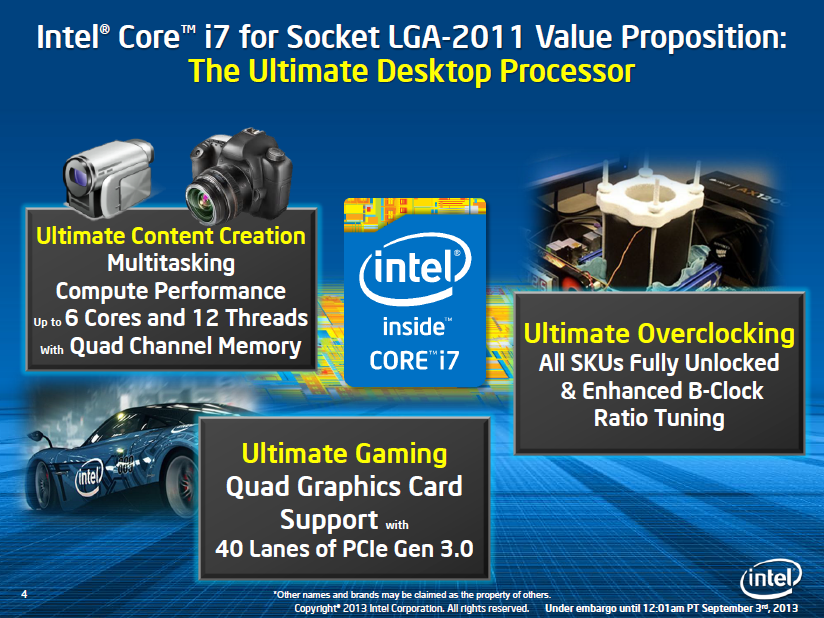
Testbed and Methods
Since this review is dedicated to the new generation of LGA2011 CPUs, we’ve collected all the three Ivy Bridge-E models for our tests.
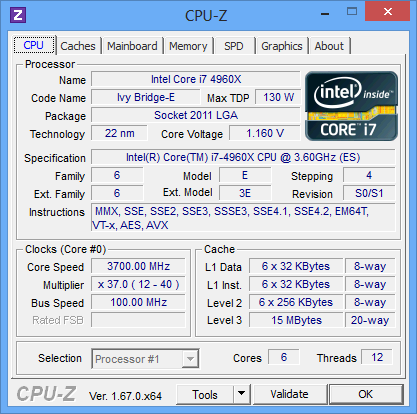
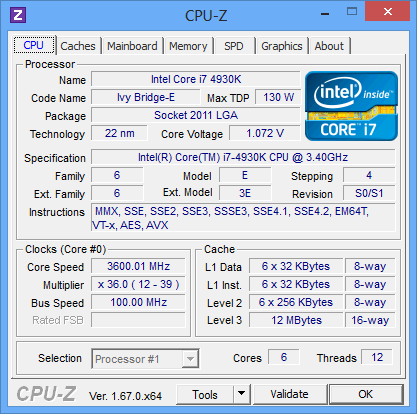
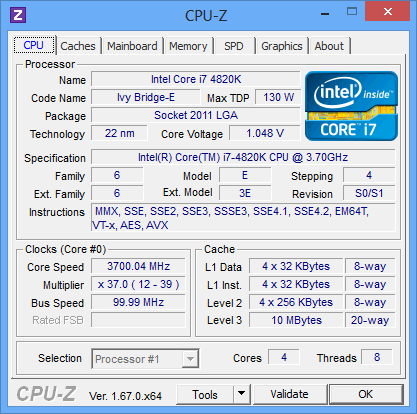
We are going to test them in comparison with their predecessors from the Sandy Bridge-E generation and with the top-end CPUs for the LGA1155 and LGA1150 platforms. Here’s a full list of hardware components we use for our today’s test session.
- Processors:
- AMD FX-9370 (Vishera, 8 cores, 4.4 – 4.7 GHz, 4×2 L2, 8 MB L3)
- Intel Core i7-4960X Extreme Edition (Ivy Bridge-E, 6 cores + HT, 3.6 – 4.0 GHz, 6×256 KB L2, 15 MB L3)
- Intel Core i7-4930K (Ivy Bridge-E, 6 cores + HT, 3.4 – 3.9 GHz, 6×256 KB L2, 12 MB L3)
- Intel Core i7-4820K (Ivy Bridge-E, 4 cores + HT, 3.7 – 3.9 GHz, 4×256 KB L2, 10 MB L3)
- Intel Core i7-4770K (Haswell, 4 cores + HT, 3.5 – 3.9 GHz, 4×256 KB L2, 8 MB L3)
- Intel Core i7-3970X Extreme Edition (Sandy Bridge-E, 6 cores + HT, 3.5 – 4.0 GHz, 6×256 KB L2, 15 MB L3)
- Intel Core i7-3930K (Sandy Bridge-E, 6 cores + HT, 3.2 – 3.8 GHz, 6×256 KB L2, 15 MB L3)
- Intel Core i7-3820 (Sandy Bridge-E, 4 cores + HT, 3.6 – 3.8 GHz, 4×256 KB L2, 10 MB L3)
- Intel Core i7-3770K (Ivy Bridge, 4 cores + HT, 3.5 – 3.9 GHz, 4×256 KB L2, 8 MB L3)
- CPU cooler: Noctua NH-U14S
- Mainboards:
- ASUS M5A99FX PRO R2.0 (Socket AM3+, AMD 990FX + SB950)
- ASUS P8Z77-V Deluxe (LGA1155, Intel Z77 Express)
- ASUS Rampage IV Formula (LGA2011, Intel X79 Express)
- Gigabyte Z87X-UD3H (LGA1150, Intel Z87 Express)
- System memory:
- 2 x 8 GB DDR3-2133 SDRAM, 9-11-11-31 (G.Skill [TridentX] F3-2133C9D-16GTX)
- 4 x 8 GB DDR3-2133 SDRAM, 9-11-11-31 (G.Skill [TridentX] F3-2133C9Q-32GTX)
- Graphics card: Nvidia GeForce GTX 780 (3 GB/384-bit GDDR5, 863-902/6008 MHz)
- Storage: Intel SSD 520 240GB (SSDSC2CW240A3K5)
- Power Supply: Corsair AX760i (80 Plus Platinum, 760 W).
- AMD Chipset Driver 13.9
- Intel Chipset Driver 9.4.0.1027
- Intel Management Engine Driver 9.0.2.1345
- Intel Rapid Storage Technology 12.8.0.1016
- Nvidia GeForce 327.23 Driver
We run our tests in Microsoft Windows 8 Enterprise x64 using the following drivers:
Synthetic Benchmarks: Ivy Bridge-E vs. Haswell
Before our full-scale testing of the new Ivy Bridge-E processors we want to check out what performance per CPU core they can offer. We really feel some doubts about Intel’s decision to update its flagship CPU series using not the most advanced microarchitecture. The high number of computing cores may make up for that, yet not all applications can utilize six CPU cores, especially with Hyper-Threading enabled. Moreover, the Ivy Bridge-E series includes a quad-core model, Core i7-4820K, which has a slightly higher clock rate, a larger L3 cache and a quad-channel memory controller in comparison with the Core i7-4770K, the top-end Haswell-based LGA1150 model. Is it enough to justify the higher model number, especially as the LGA1150 processors not only feature a more progressive microarchitecture but also support the FMA/AVX2 instructions?
To answer this question and better understand the highs and lows of the Ivy Bridge-E design, we began by comparing the quad-core processors, Core i7-4820K and Core i7-4770K, at the same clock rate of 4.0 GHz. To make the picture complete, we added the previous-generation LGA2011 processor Core i7-3820.
Synthetic benchmarks are the best way to form your first impression about the peculiarities of CPU designs. We use SiSoftware Sandra 2013 SP6 for that purpose.
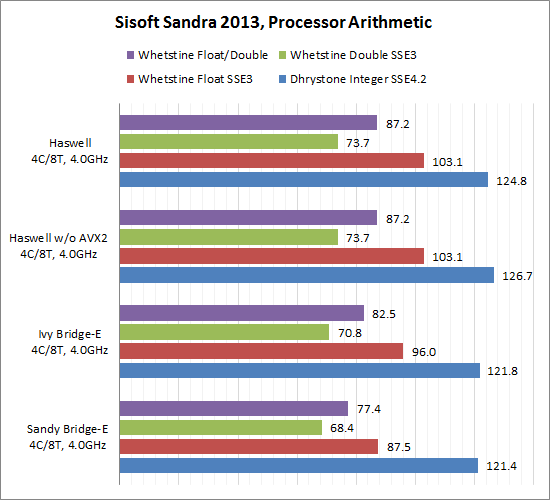
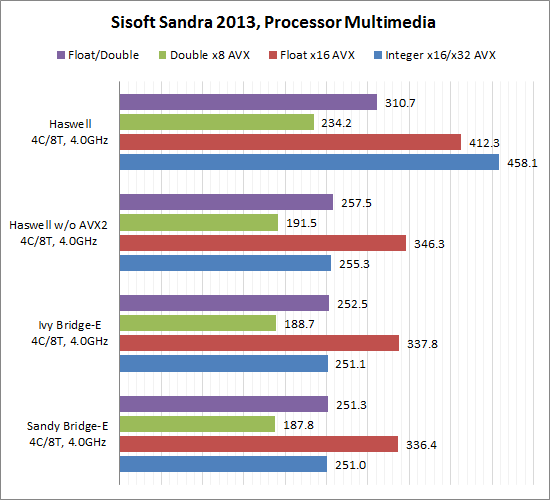
Frankly speaking, there’s nothing unexpected about these results. The Ivy Bridge-E design copies the familiar Ivy Bridge, transferring the microarchitecture to another platform. That’s why the Ivy Bridge-E is but slightly superior to its predecessor in terms of per-core performance. We can only see it with integer operations where the newer microarchitecture can improve performance by up to 10%.
It turns out that the LGA2011 platform accelerates more through higher clock rates rather than through internal improvements. The clock rates are not much higher, though, so the new LGA2011 CPUs are going to be just 5 to 10% faster than the older ones.
The Ivy Bridge-E is considerably inferior to the Haswell in terms of per-core performance. Even if we put aside the new AVX2 instructions which can improve performance of many popular algorithms, the quad-core Haswell is always ahead of the quad-core Ivy Bridge-E by 6 to 7%. It turns out that the LGA1150 platform offers more progressive processors and the new LGA2011 CPUs can only be superior by having more computing cores.
The larger L3 cache together with the high-performance 4-channel memory controller seem to be one of the advantages of the Ivy Bridge-E over the Haswell design but there are nuances that make this advantage questionable. First of all, the caching mechanism of the Ivy Bridge-E is slower than in the Haswell. The bandwidth tests make it clear.
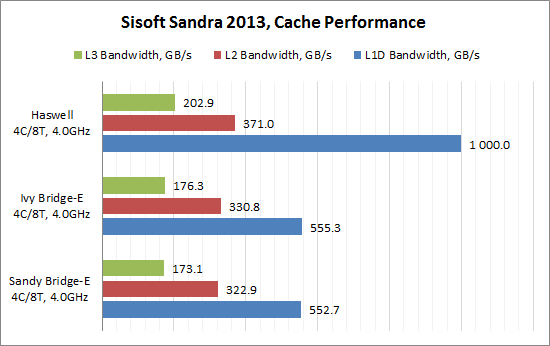
The Haswell has higher L1 and L2 cache bandwidth, which shows up in practical applications. The Ivy Bridge-E and Haswell are comparable in terms of cache latency, though.

Secondly, the practical speed of the quad-channel memory controller is not much higher compared to the Haswell’s dual-channel controller:
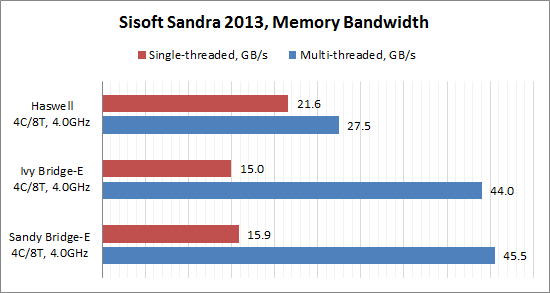
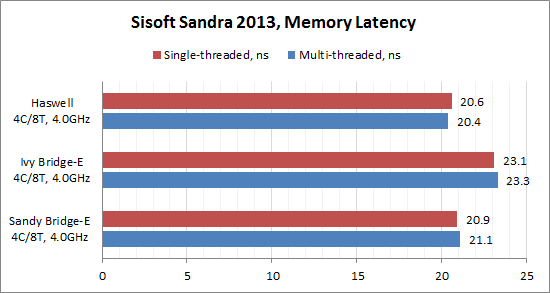
The results you can see in the diagram refer to the peak bandwidth which is achieved at multithreaded memory access whereas everyday applications access memory in one thread, producing a different picture of practical bandwidth.
The Haswell’s memory controller copes better with typical desktop loads, even though has much lower theoretical bandwidth. The Ivy Bridge-E’s controller is optimized for multithreaded server applications but its four channels are not so good otherwise. This was typical of the Sandy Bridge-E CPUs and the new CPU generation has the same peculiarity.
Now that we know about the highs and lows of the Ivy Bridge-E design, it’s time to benchmark it in real-life applications.
Performance Tests
General Performance
As usual, we use the Bapco SYSmark 2012 suite to estimate performance in general-purpose tasks. It emulates a user working in popular office and digital content creation and processing applications. The idea behind this test is fairly simple: it produces a single score indicative of the computer’s average performance across different applications. After the Windows 8 launch, SYSmark 2012 got updated to version 1.5, so we use that adapted version for our tests.
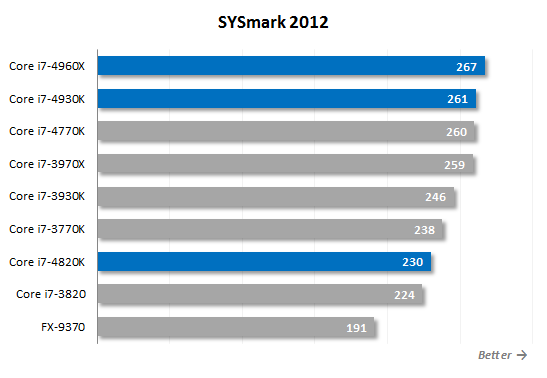
As expected, the Ivy Bridge-E processors are 3 to 6% faster than their predecessors, largely due to the difference in their clock rates. Yet even this small improvement is enough to make the $583 Core i7-4930K as fast as the $1000 Core i7-3970X Extreme Edition which belongs to the previous generation.
The top-end Haswell-based CPU has become a dangerous opponent for the LGA2011 platform. The quad-core Core i7-4770K is almost as fast as the six-core Ivy Bridge-E, suggesting that Intel has been too slow to update its enthusiast-targeted solution. Moreover, the difference in the CPU designs for the LGA2011 and LGA1150 platforms makes the new quad-core Ivy Bridge-E (Core i7-4830K) look very poor in comparison with the Haswell. It is slower by up to 13%, which makes the very idea of a quad-core Ivy Bridge-E dubious.
Let’s take a closer look at the performance scores SYSmark 2012 generates in different usage scenarios. The Office Productivity scenario emulates typical office tasks, such as text editing, spreadsheets, email and web-surfing. This scenario uses the following applications: ABBYY FineReader Pro 10.0, Adobe Acrobat Pro 9, Adobe Flash Player 10.1, Microsoft Excel 2010, Microsoft Internet Explorer 10, Microsoft Outlook 2010, Microsoft PowerPoint 2010, Microsoft Word 2010 and WinZip Pro 14.5.
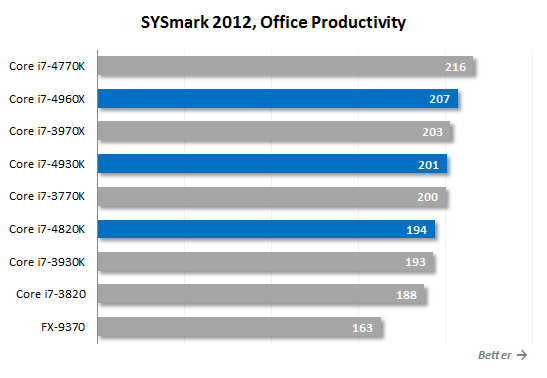
The Media Creation scenario emulates the creation of a video clip out of prepared materials (digital images and videos) using popular tools from Adobe: Photoshop CS5 Extended, Premiere Pro CS5 and After Effects CS5.
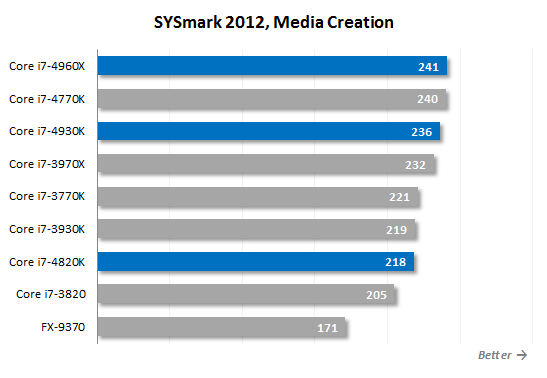
Web Development is a scenario emulating website authoring. It uses the following applications: Adobe Photoshop CS5 Extended, Adobe Premiere Pro CS5, Adobe Dreamweaver CS5, Mozilla Firefox 3.6.8 and Microsoft Internet Explorer 10.
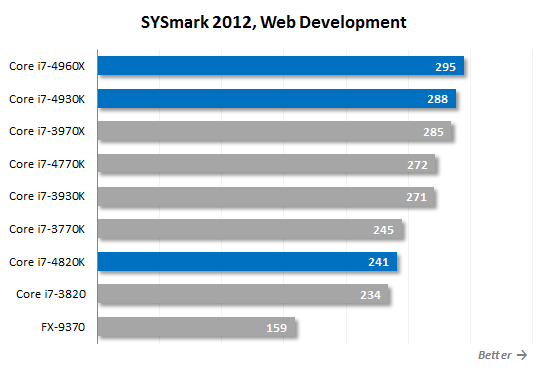
The Data/Financial Analysis scenario is devoted to statistical and market analysis by means of Microsoft Excel 2010.
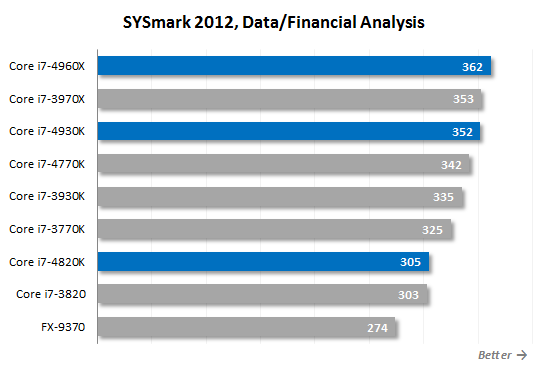
The 3D Modeling scenario is about creating 3D models and rendering static and dynamic scenes using Adobe Photoshop CS5 Extended, Autodesk 3ds Max 2011, Autodesk AutoCAD 2011 and Google SketchUp Pro 8.
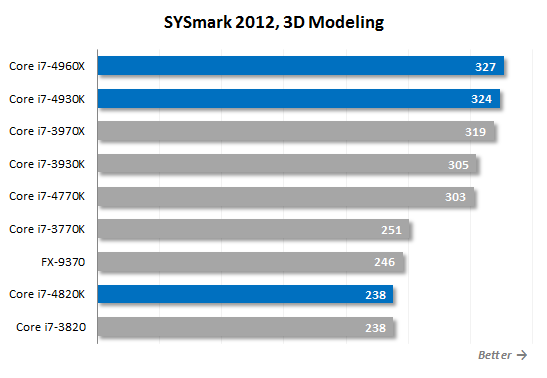
The last scenario, System Management, creates backups and installs software and updates. It involves several different versions of Mozilla Firefox Installer and WinZip Pro 14.5.
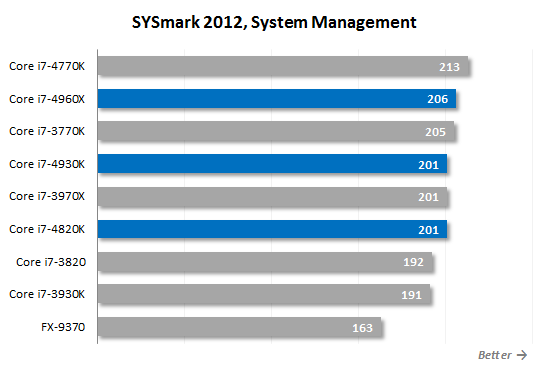
The results of our CPUs in the different usage scenarios prove what we’ve already said above. Intel’s procrastination in updating the microarchitecture of its flagship CPUs has provoked an internal competition between the LGA1150 and LGA2011 platforms. The Ivy Bridge-E series can’t be viewed as the fastest CPUs available today. The extra computing cores, larger L3 cache and higher clock rates do not help them beat the Haswell, so the Core i7-4770K proves to be a more preferable choice for office and system applications than the Core i7-4960X Extreme Edition. On the other hand, the LGA2011 platform is unrivalled when it comes to multithreaded applications (web development, financial calculations, 3D modeling, etc), which means that the Ivy Bridge-E is optimal for high-performance workstations rather than for home computers.
Now let’s check out the new Ivy Bridge-E CPUs in specific applications, starting from games.
Gaming Performance
As you know, it is the graphics subsystem that determines the performance of the entire platform in the majority of contemporary games if the platform has a fast enough processor. Therefore, we select the most CPU-dependent games and measure the frame rate in two test modes. For the first mode we use lower resolutions and disable full-screen antialiasing, so we could see how well the processor can cope with gaming loads in general. This provides some insight into how the tested CPU is going to behave in the nearest future when it is accompanied with faster graphics cards. The second test mode refers to real-life settings: Full HD and maximum FSAA. In our opinion, these results are no less interesting as they demonstrate clearly the level of performance we can expect from contemporary processors today.
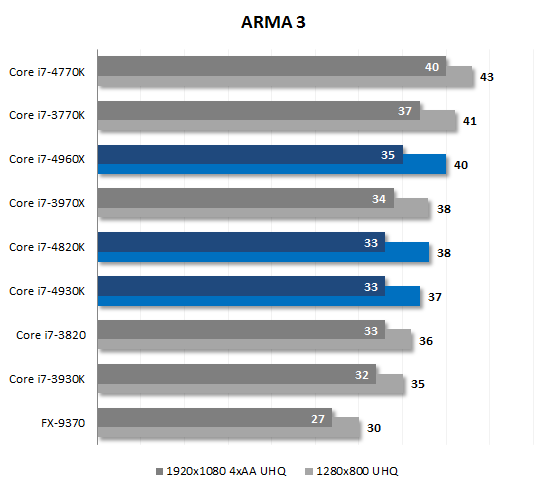
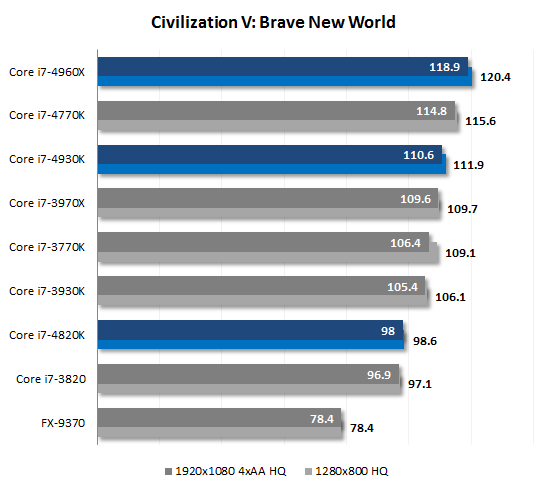
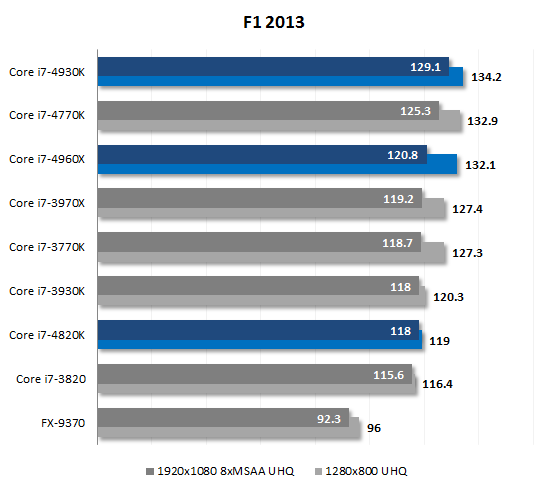
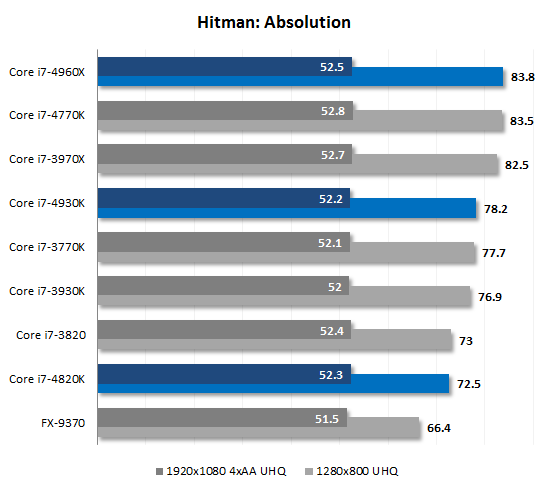
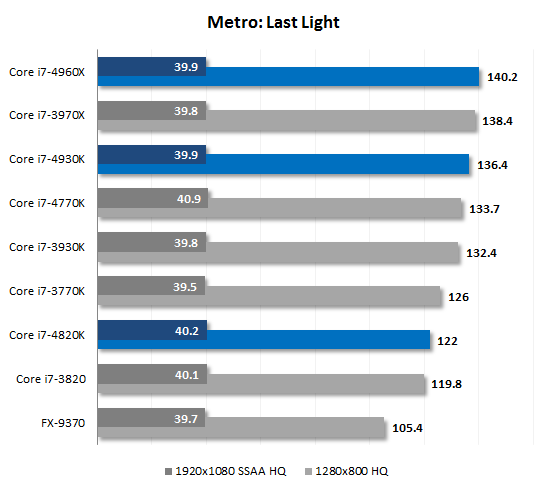
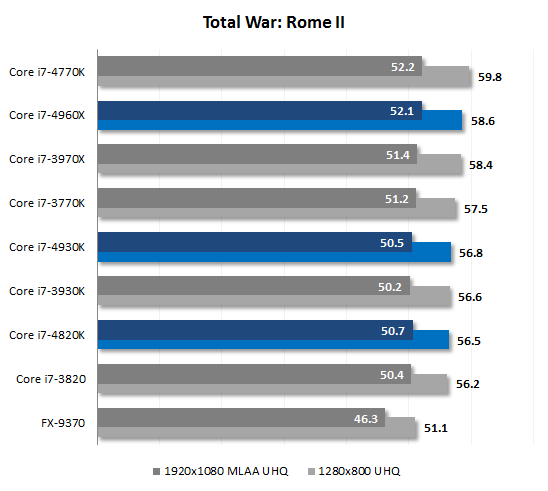
The gaming tests suggest that the LGA2011 platform doesn’t bring any special advantages to gamers. The top-end Haswell-based CPU, Core i7-4770K, with its progressive microarchitecture, fast cache and memory controller optimized for single-threaded loads, is quite competitive against the six-core Ivy Bridge-E in games. Its performance is comparable to that of the Core i7-4930K. The top-end six-core model Core i7-4960X Extreme Edition often takes the top place as today’s games have come to effectively use multiple CPU cores. It is only inferior to the Core i7-4770K in ARMA 3 and Total War: Rome II. We shouldn’t forget, however, that building a gaming configuration with a Core i7-4960X is going to be twice or thrice as expensive as with a Core i7-4770K whereas the difference in performance will be negligible.
The non-Extreme Ivy Bridge-E models don’t look good as gaming solutions. The six-core Core i7-4930K is no faster than the Core i7-4770K under gaming loads while the quad-core Core i7-4820K looks a complete loser among the other Core i7 CPUs. It is even slower than the similarly designed Core i7-3770K, illustrating the fact that the quad-channel memory controller slows down the gaming performance of the LGA2011 platform rather than otherwise.
We’ll finish our gaming tests by running the popular synthetic benchmark 3DMark.
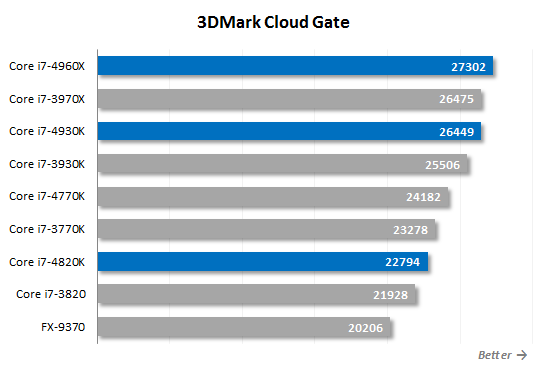
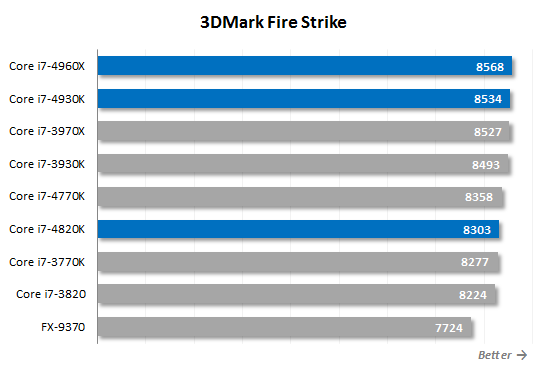
Futuremark 3DMark is optimized for multi-core CPUs, so the Ivy Bridge-E series are better here than in the actual games, but there’s a trend for modern games to support multithreading. 3DMark suggests that the six-core CPUs are the best choice but the Core i7-4770K remains the fastest of the quad-core models, pushing back the quad-core LGA2011 solution, Core i7-4820K.
Application Tests
In Autodesk 3ds max 2014 we benchmark the speed of mental ray rendering of a complex 3D scene.
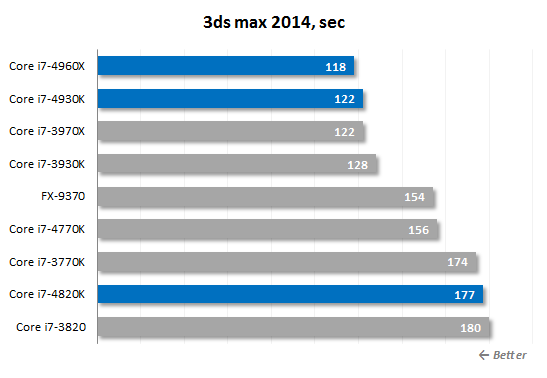
Final rendering is a type of computing task that can be easily run on multiple CPU cores. That’s why the six-core LGA2011 CPUs take the top positions in the diagram. 3ds max 2014 highlights the benefits of the Ivy Bridge-E design as such CPUs are somewhat faster than their opponents with the same number of cores. As for the quad-core Ivy Bridge-E, it is not satisfactory here, falling 13% behind the Core i7-4770K which belongs to a lower-class platform.
We also benchmark 3D rendering performance with Cinebench R15. Maxon has recently updated it, so it can now measure the speed of computing platforms in the latest versions of the Cinema 4D animation suite.
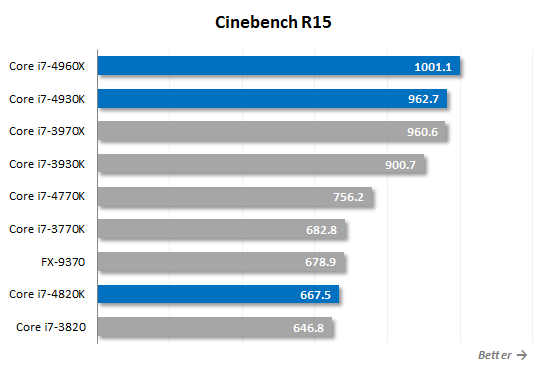
The diagram shows the same rankings we’ve just seen in 3ds max. The number of CPU cores is the first most important factor for this test, the CPU microarchitecture being the second. The six-core CPUs take top places but the Haswell-based models are better than their opponents with the same number of cores. By the way, AMD’s 8-core CPU is comparable to Intel’s quad-core CPUs since the latter can also execute eight instruction threads concurrently thanks to their Hyper-Threading technology.
In Adobe’s After Effects CC we measure the speed of classic rendering of a 3D video with a set of filters and special effects.
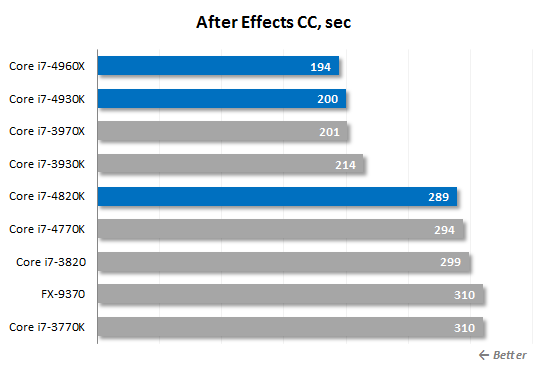
Creating special effects in After Effects turns out to be alike to final rendering. The number of CPU cores is the most important factor again – with one peculiarity. The latest version of After Effects is one of the few applications that can make use of the advantages offered by the quad-channel memory controller of LGA2011 CPUs. As a result, the Core i7-4960X is 50% faster than the Core i7-4770K while the Core i7-4820K also beats the senior quad-core LGA1150 model.
The test scenario for Adobe Photoshop Lightroom 5.2 includes post-processing and exporting into JPEG format of two hundred 12-megapixel RAW images captured with a Nikon D300.
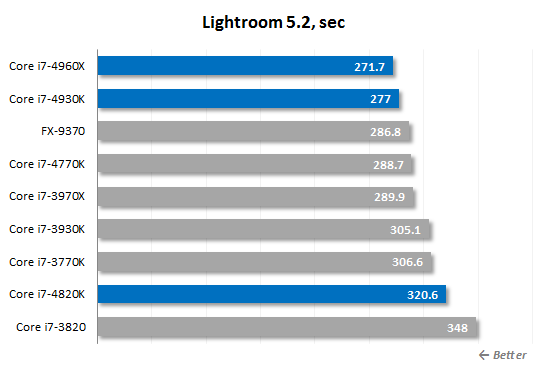
The Ivy Bridge-E CPUs are still ahead but the Core i7-4770K isn’t much slower. AMD’s FX-9370 is quite good at batch processing of photos, too. As for the quad-core LGA2011 processors, they are not good for Lightroom: the Core i7-4770K is 11% ahead of the new Core i7-4820K.
We benchmark CPUs in Adobe Photoshop CS6 using our custom test that is based on the Retouch Artists Photoshop Speed Test and consists of typical processing of four 24-megapixel images captured with a digital camera.
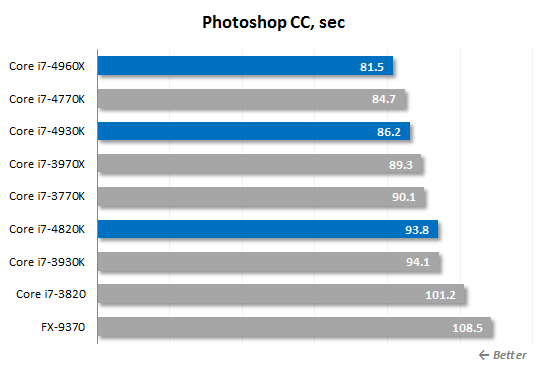
It is a shame we don’t test Haswell-E CPUs today. Although the Haswell microarchitecture didn’t improve performance as much as we had anticipated, it is an improvement anyway. Thanks to that, the quad-core Core i7-4770K is ahead of the new quad-core Ivy Bridge-E processor and is only 4% behind the top-end six-core Ivy Bridge-E. In other words, the Core i7-4770K is faster than the new six-core Core i7-4930K.
The performance in Adobe Premiere Pro CC is measured as the time it takes to render a Blu-ray project with HDV 1080p25 video into H.264 format and apply special effects to it.
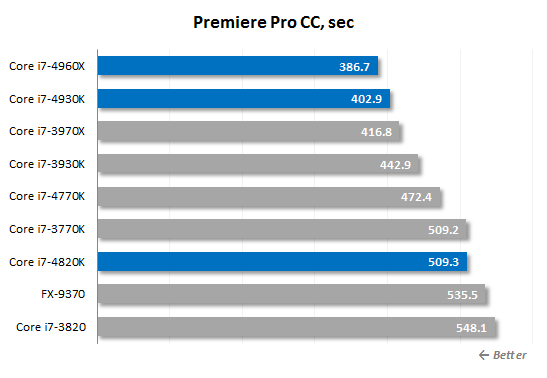
Processing video is what the LGA2011 platform, particularly with six-core CPUs, is good at. We can also see that the Ivy Bridge-E models are up to 8% faster than their Sandy Bridge-E predecessors. As for the quad-core CPUs, the Haswell is again ahead of its LGA2011 opponents.
The processors’ performance in cryptographic tasks is measured with the built-in benchmark of the popular TrueCrypt utility that uses AES-Twofish-Serpent encryption. Besides optimizations for multi-core CPUs, it supports the AES instructions.
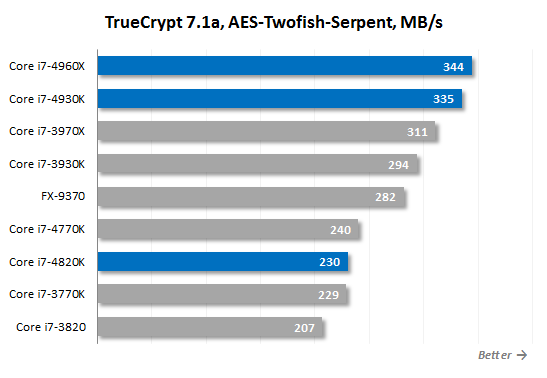
The new six-core CPUs look good in this test. The Ivy Bridge-E design is 10 to 14% better than the Sandy Bridge-E, yet the top-end Haswell is faster than the quad-core LGA2011 model Core i7-4820K. Unfortunately, the latter is a poor alternative to today’s LGA1150 solutions. We just can’t find any reason to buy a Core i7-4820K.
To test the processors’ performance at data archiving we use WinRAR 5.0. Using maximum compression rate, we archive a 1.7GB folder with multiple files.
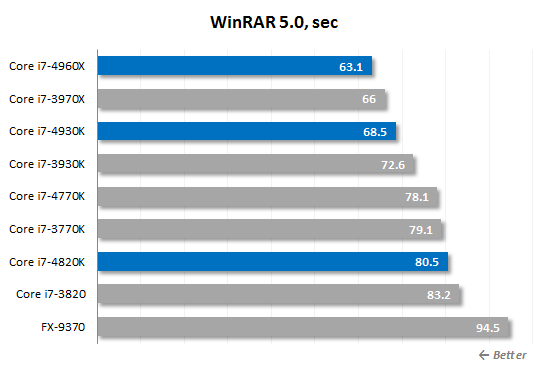
The WinRAR developers have optimized their application for multi-core CPUs, so we’ve got only six-core models in the top of the diagram. The Ivy Bridge-E design is 5 to 6% faster than the Sandy Bridge-E due to some improvements in the microarchitecture and higher clock rates. However, the Haswell is superior among the quad-core models. Although data compression requires high memory bandwidth, the Core i7-4770K with its dual-channel DDR3 SDRAM controller is somewhat faster than the new Core i7-4820K with quad-channel controller, even though the latter CPU has a higher clock rate.
In order to measure how fast the tested CPUs can transcode video into H.264 format we used x264 FHD Benchmark 1.0.1 (64 bit). It measures the time it takes the x264 coder to convert an MPEG-4/AVC video recorded in 1920×1080@50fps resolution with 30 Mbps bitrate. The results have high practical value, because the x264 codec is part of popular transcoding utilities, such as HandBrake, MeGUI, VirtualDub, etc. We regularly update the coder used in this performance test. This time around, we use version r2358, which supports all contemporary instruction sets including AVX2.
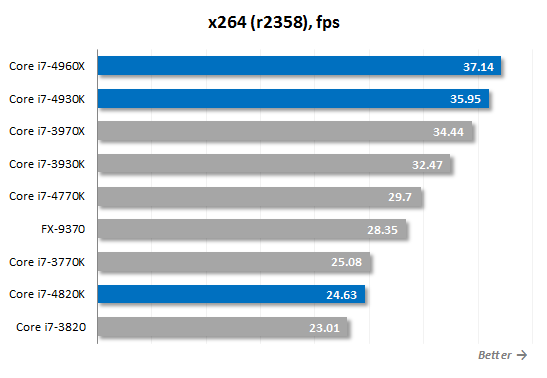
Encoding video with the x264 codec is an interesting test as it is constantly evolving to support the newest instruction sets. The Haswell shows an impressive result because it is the only CPU to support the AVX2 instructions. On the other hand, six cores are a more important factor, so the Core i7-4960X and Core i7-4930K are even faster, just like their six-core predecessors. The quad-core Ivy Bridge-E model, Core i7-4820K, is rather slow as in most of the previous tests. It is 20% slower than the Core i7-4770K which features a more progressive microarchitecture and supports modern SIMD instruction sets.
Encoding video with a bare coder is hardly a real-life application, so we want to check out the speed of video transcoding with the popular free tool Freemake Video Converter 4.0.4. It uses the FFmpeg library and is based on the x264 coder too, but features certain optimizations. We disable CUDA and DXVA for this test to create maximum load on the CPUs’ computing cores.
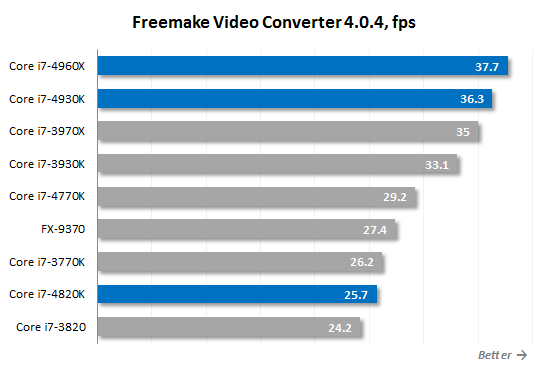
As expected, the speed of video transcoding in Freemake Video Converter is overall similar to the speed of the x264 coder. The six-core Ivy Bridge-E processors can show their best at this kind of load. Their predecessors with Sandy Bridge-E design look good, too. On the other hand, the results of the Core i7-4820K make it clear that the Haswell is far more progressive, making the Ivy Bridge-E series and the LGA2011 platform look outdated.
Power Consumption
The LGA2011 platform and Sandy Bridge-E processors have never been particularly economical. At full computing load the power consumption of configurations with six-core CPUs like the Core i7-3970X would be twice that of LGA1155 or LGA1150 platforms. The Ivy Bridge-E CPUs may change this situation, though. First of all, instead of 32nm technology they are manufactured on 22nm technology with 3D transistors. And secondly, the Ivy Bridge-E semiconductor die is simpler because it has no disabled CPU cores.
We can also expect improvements in this respect because the TDP of the senior model Core i7-4960X Extreme Edition is reduced to 130 watts whereas its predecessor had a specified TDP of 150 watts. It may seem a minor difference (and the junior Ivy Bridge-E models have the same TDP as their Sandy Bridge-E counterparts) but Intel is known to specify its TDPs with a large safety margin, so we can only see the full picture in real-life tests.
So now we are going to measure the power consumption of the entire Core i7 series for the LGA2011 platform. The graphs below (unless specified otherwise) show the full power draw of the computer (without the monitor) from the wall socket. It is the total power consumption of all system components. The PSU’s efficiency is taken into account but our Corsair AX760i is a highly efficient 80 PLUS Platinum product, so its effect on the result is very small.
The CPUs are loaded by running the 64-bit version of LinX 0.6.4 utility with support for AVX and FMA instructions. Moreover, we enable Turbo mode and all power-saving technologies to correctly measure the computer’s power draw in idle mode: C1E, C6, Enhanced Intel SpeedStep and AMD Cool’n’Quiet.
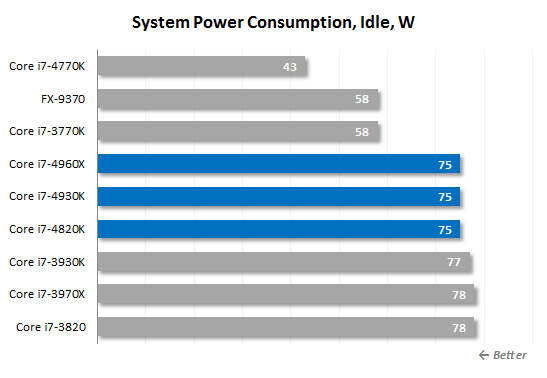
The LGA2011 platform still consumes quite a lot of power in idle mode in comparison with the other platforms. The Ivy Bridge-E CPUs ensure certain benefits over their predecessors but the overall picture remains the same. Clearly, the problem is in the platform design which implies that the CPU has a complex uncore subunit without a flexible power management mechanism.
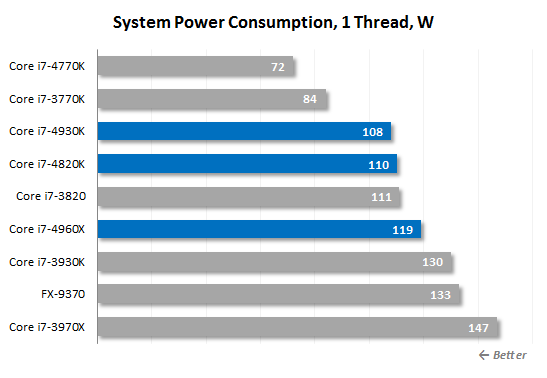
It’s somewhat different under single-threaded loads. The Ivy Bridge-E CPUs turn out to be more economical than the Sandy Bridge-E models or the AMD FX-9370. On the other hand, the LGA1150 and LGA1155 CPUs need even less power.
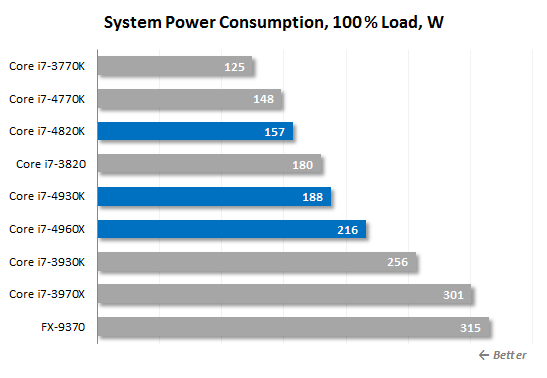
The new Ivy Bridge-E CPUs aren’t very economical at full loads, yet they are better than their Sandy Bridge-E counterparts. The Core i7-4960X needs 85 watts less than the Core i7-3970 whereas the Core i7-4930K needs 68 watts less than the Core i7-3930K. Thus, the new 22nm six-core CPUs from Intel offer higher performance per watt than their predecessors, largely due to the fact that the Ivy Bridge-E CPUs work at lower voltage.
By the way, the quad-core LGA2011 processor Core i7-4820K is close to the Haswell-based Core i7-4770K in terms of power consumption. This is rather an illustration of the increased power requirements of the LGA1150 platform than of any improvements in the Ivy Bridge-E design. After all, the new Ivy Bridge-E CPUs, even though reduce the power consumption of the LGA2011 platform, do not make it economical. You should avoid this platform if you want an energy-efficient computer.
Overclocking
After our experience of overclocking Haswell-based CPUs we had high hopes about the overclocking potential of the updated LGA2011 platform. The problem with the desktop Haswell-based CPUs is that they have inferior thermal interface material between the CPU cap and the CPU die. It is therefore difficult to cool them – they quickly overheat when overclocked, so their overclocking potential is far from impressive.
It’s different with the LGA2011 CPUs. Intel employs fluxless soldering for them, so the CPU die transfers its heat to the CPU cap via indium-based solder. That’s why the success of your overclocking an Ivy Bridge-E CPU depends on your cooler’s efficiency and is not limited by any other factors.
As for the overclocking tools the new CPU design offers, there are almost no differences from the Sandy Bridge-E. Each Ivy Bridge-E processor has an unlocked frequency multiplier while the base clock rate can be set at 100 or 125 MHz (and also at 167 MHz in some cases). The memory frequency can be adjusted with a step of 266 MHz up to DDR3-3200 mode when the base clock rate is 100 MHz. When the latter is 125 MHz, the adjustment step is 333 MHz.
In fact, there are only two overclocking innovations in the Ivy Bridge-E. The new CPUs support real-time overclocking (without rebooting to apply new parameters) and the maximum multiplier is now x63.
Let’s see what practical results can be achieved by overclocking Ivy Bridge-E processors. We should note that we don’t want to set any overclocking records. Our goal is to find the peak frequency the CPU can work at continuously in 24/7 mode. That’s why we restrain our voltage adjustments, use a single-section tower-design cooler Noctua NH-U14S, and keep the CPU temperature below the throttling threshold (which is set at 95°C for the Ivy Bridge-E).
So, the quad-core Core i7-4820K turned out to be the most overclocker-friendly CPU in our tests. Its result is quite exceptional in comparison with the new Haswell-based CPUs: it can work at 4.8 GHz and a voltage of 1.375 volts.
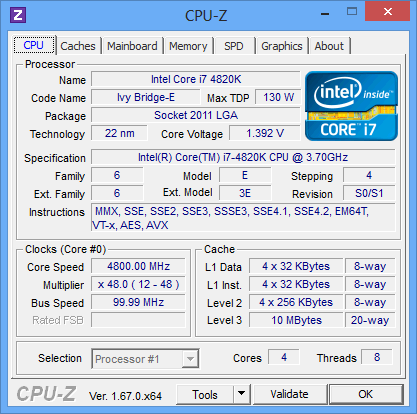
The peak temperature of the CPU cores varied from 78°C to 88°C when running the AVX-supporting LinX 0.6.4. We thought that was quite acceptable since the Core i7-4820K has a higher thermal throttling threshold (100°C) than its six-core cousins.
The midrange model Core i7-4930K wasn’t so successful. Its six cores generate much more heat, calling for more advanced coolers, perhaps even liquid cooling systems. Using our air cooler Noctua NH-U14S, we had to content ourselves with 4.6 GHz at a voltage of 1.325 volts.
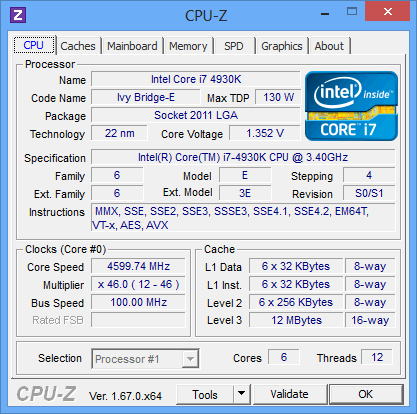
The CPU cores had a temperature of 74°C to 83°C at high loads. Moreover, to ensure stability of our Core i7-4930K, we had to increase its uncore voltage to 1.2 volts.
The senior LGA2011 processor Core i7-4960X (from the Extreme Edition series) gets much hotter than its cousins when overclocked. That’s why its end result is lower. When its core and uncore voltage was increased to 1.35 and 1.2 volts, respectively, we made the CPU stable at only 4.5 GHz.
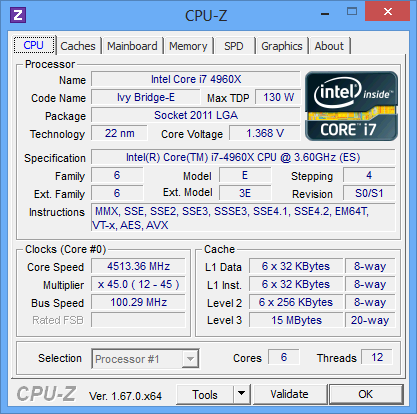
It doesn’t mean that this is the maximum our Core i7-4960X can do. We just had to limit ourselves to that frequency with our cooler to avoid overheat: the temperature was already as high as 75°C to 85°C.
Summing it up, the updated LGA2011 platform really pleased us with its overclocking potential. Besides the higher maximum frequencies (in comparison with the Haswell generation), the Ivy Bridge-E, just like the Sandy Bridge-E, is overclocked in an easy and comprehensible way. You increase its clock rate, add more voltage to improve stability, and make up for the increased temperature by using a better cooler. That’s the recipe. There are no hindrances or pitfalls as with the Haswell or Ivy Bridge CPUs for the LGA1150 and LGA1155 platforms. It is a huge advantage of the LGA2011 platform that appeals to overclockers.
As for the frequency potential of Ivy Bridge-E processors in comparison with their Sandy Bridge-E predecessors, there are no fundamental improvements. Although the new LGA2011 products are manufactured on Intel’s most advanced 22nm technology, they cannot reach 5 GHz with air cooling. Still, the LGA2011 platform is a good choice for enthusiasts and overclockers who are going to run their Ivy Bridge-E processors with more efficient coolers than ours and thus achieve higher clock rates.
Conclusion
We’ve never been particularly excited about the LGA2011 platform. It has been a niche product since its very inception, targeted at the narrow category of users who need six-core CPUs. And six-core CPUs are only really necessary for high-performance workstations. In everyday applications, particularly in games, four cores is just enough if we talk about Intel CPUs.
The desktop LGA2011 platform is an adaptation of a server solution, which means a lot of issues like the low performance of the memory controller at single-threaded loads or the high power consumption. The biggest issue is that the platform evolves too slowly. When the early Sandy Bridge-E processors hit the market, we had the desktop LGA1155 platform with Sandy Bridge CPUs and there were no questions about the more advanced version of a regular platform. The situation is different now. The new mass platform LGA1150 offers more up-to-date processors based on the Haswell microarchitecture whereas the enthusiast-targeted platform has CPUs with the older Ivy Bridge design.
Besides a certain emotional dissonance, it narrows the scope of applications the LGA2011 platform is optimal for. As we’ve seen in our performance tests, the Core i7-4820K, the junior quad-core Ivy Bridge-E model, cannot compete against the Core i7-4770K and thus looks completely pointless. The midrange Core i7-4930K with six cores is on average comparable to the senior quad-core Haswell-based model except for the final rendering and video editing tests. The senior $1000 Core i7-4960X Extreme Edition deserves its flagship status, yet its advantage over the Core i7-4770K is small in most of benchmarks while the price difference is substantial. Thus, an LGA1150 configuration with a top-end CPU is going to be more optimal in most cases, even for gamers and enthusiasts.
Granted, the Ivy Bridge-E have improved over the Sandy Bridge-E generation. They are 5 to 10% faster, need considerably less power, and offer the same or better overclocking potential. But the Ivy Bridge-E design, although formally new, is in fact outdated already. So if you plan to buy such a CPU and prefer the LGA2011 platform, you should be aware that you pay for an old product that lacks many benefits offered by the more up-to-date CPUs.
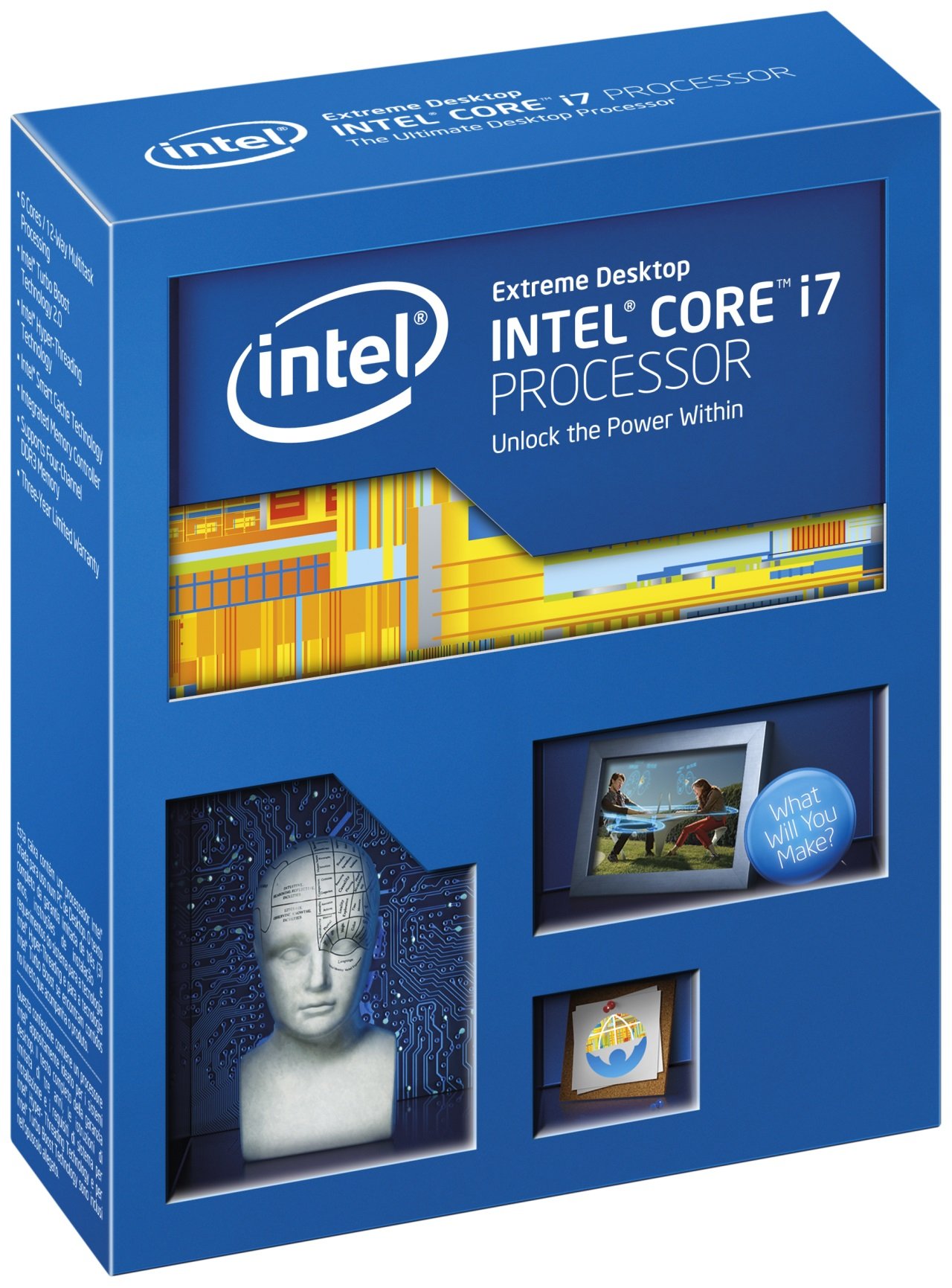
It should also be added that the Intel X79, the only chipset for Ivy Bridge-E CPUs, hasn’t been updated since times immemorial. It doesn’t support USB 3.0 and offers but two SATA 6 Gbit/s ports. Of course, mainboard makers can make up for this deficiency by installing a lot of onboard controllers, but this makes mainboards more expensive and may provoke certain compatibility or performance issues.
So, we can only recommend the current implementation of the LGA2011 platform with the six-core Ivy Bridge-E processors to users who need maximum multithreaded performance or high amounts of system memory (as this platform can offer as many as eight DIMM slots). In other words, today’s LGA2011 CPUs are optimal for workstations rather than for ordinary desktop PCs. And when it comes to workstations, Intel’s Xeon E5 v2 series may be a better choice as they offer eight or even ten computing cores.